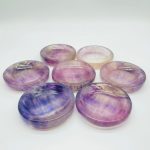Origins and Formation of Madagascar Agate
Madagascar agate, a captivating gemstone renowned for its vibrant colors and intricate patterns, originates from the volcanic heartland of Madagascar. The genesis of this enigmatic stone lies in the ancient lava flows that solidified and crystallized over millions of years. These lava pockets were subsequently filled with a mosaic of silica minerals, primarily chalcedony and quartz, that transformed into the exquisite agate we cherish today.

Physical Properties and Varieties
Madagascar agate exhibits a remarkable range of physical properties and varieties. The Mohs scale of mineral hardness assigns it a value of 6.5 to 7, indicating its durability and resistance to scratches. Its specific gravity ranges from 2.5 to 2.6, reflecting its density. Madagascar agate is a cryptocrystalline mineral, meaning it consists of tiny crystals that are too small to be discerned with the naked eye.
The hues of Madagascar agate span a kaleidoscope of colors, including vibrant blues, calming greens, warm yellows, soothing purples, fiery reds, and earthy browns. These colors arise from trace elements and impurities within the agate. For instance, iron oxides contribute to reddish hues, while copper compounds impart greenish shades.
Geological Significance
Madagascar agate serves as a valuable tool for geologists. By studying its layers and inclusions, scientists can glean insights into the volcanic and geological history of Madagascar. The presence of certain minerals within the agate, such as sulfur and iron compounds, can provide clues about the composition of the original lava. Additionally, Madagascar agate can be used to estimate the age of geological formations, as it forms over extensive periods of time.
Healing Properties and Metaphysical Beliefs
Madagascar agate has long been associated with healing properties and metaphysical beliefs. Various cultures attribute different healing powers to this stone, ranging from emotional stabilization to physical rejuvenation. Some individuals believe that wearing or carrying Madagascar agate promotes calmness, reduces stress, and alleviates anxiety.
Commercial and Decorative Applications
The captivating beauty of Madagascar agate has made it a highly sought-after gemstone for jewelry and decorative purposes. Its intricate patterns and vibrant colors lend themselves to stunning jewelry pieces, including necklaces, bracelets, earrings, and rings. Madagascar agate is also widely used in home décor, adorning tables, walls, and other surfaces as a unique and captivating accent.
New Applications for Madagascar Agate
Beyond its traditional uses, Madagascar agate has sparked innovative applications in recent years. Its unique patterns and durability have inspired designers to incorporate it into textiles, creating stunning fabrics and garments. The stone’s natural beauty has also found its way into skincare products, where its energy is said to enhance skin health and radiance.
Tips and Tricks for Utilizing Madagascar Agate
To maximize the benefits and beauty of Madagascar agate, consider the following tips and tricks:
- Cleaning: Madagascar agate can be cleaned using a mild soap solution and a soft cloth. Avoid using harsh chemicals or abrasive cleaners.
- Storage: Store Madagascar agate in a cool, dry place away from direct sunlight to preserve its color and luster.
- Jewelry Care: When wearing Madagascar agate jewelry, avoid exposing it to harsh chemicals or excessive force. Clean your jewelry regularly using a soft cloth and a mild soap solution.
- Meditation and Healing: To harness the healing properties of Madagascar agate, hold it in your hand or place it near your body during meditation. Allow the stone’s energy to flow through you and promote a sense of calm and relaxation.
FAQs on Madagascar Agate
1. What is the difference between Madagascar agate and other varieties of agate?
Madagascar agate is known for its particularly vibrant colors and intricate patterns, which set it apart from other agate varieties.
2. Is Madagascar agate durable?
Yes, Madagascar agate has a Mohs hardness of 6.5 to 7, making it relatively resistant to scratches and wear.
3. Where can I find Madagascar agate?
Madagascar agate is primarily mined in Madagascar, although it can also be found in certain regions of Brazil and India.
4. What are the spiritual benefits of Madagascar agate?
Madagascar agate is believed to promote emotional stability, reduce stress, and alleviate anxiety. It is also said to enhance creativity and spiritual growth.
5. Is Madagascar agate expensive?
The price of Madagascar agate varies depending on its quality, size, and patterns. High-quality specimens can fetch a premium price.
6. How can I tell if Madagascar agate is real?
Genuine Madagascar agate should have a natural luster and feel smooth to the touch. Fake or treated agates may exhibit a plastic-like appearance or uneven textures.
Tables
| Property | Value |
|---|---|
| Mohs Hardness | 6.5 – 7 |
| Specific Gravity | 2.5 – 2.6 |
| Refractive Index | 1.53 – 1.54 |
| Chemical Composition | Silica (SiO2) |
| Color | Source |
|---|---|
| Blue | Iron oxides |
| Green | Copper compounds |
| Yellow | Sulfur compounds |
| Purple | Manganese oxides |
| Red | Iron oxides |
| Healing Properties | Belief |
|---|---|
| Emotional stability | Reduces stress and anxiety |
| Physical rejuvenation | Improves skin health and radiance |
| Spiritual growth | Enhances creativity and spiritual awareness |
| New Applications | Industry |
|---|---|
| Textiles | Garments and accessories |
| Skincare | Energy-infused products |
| Cosmetics | Natural pigments and additives |




























